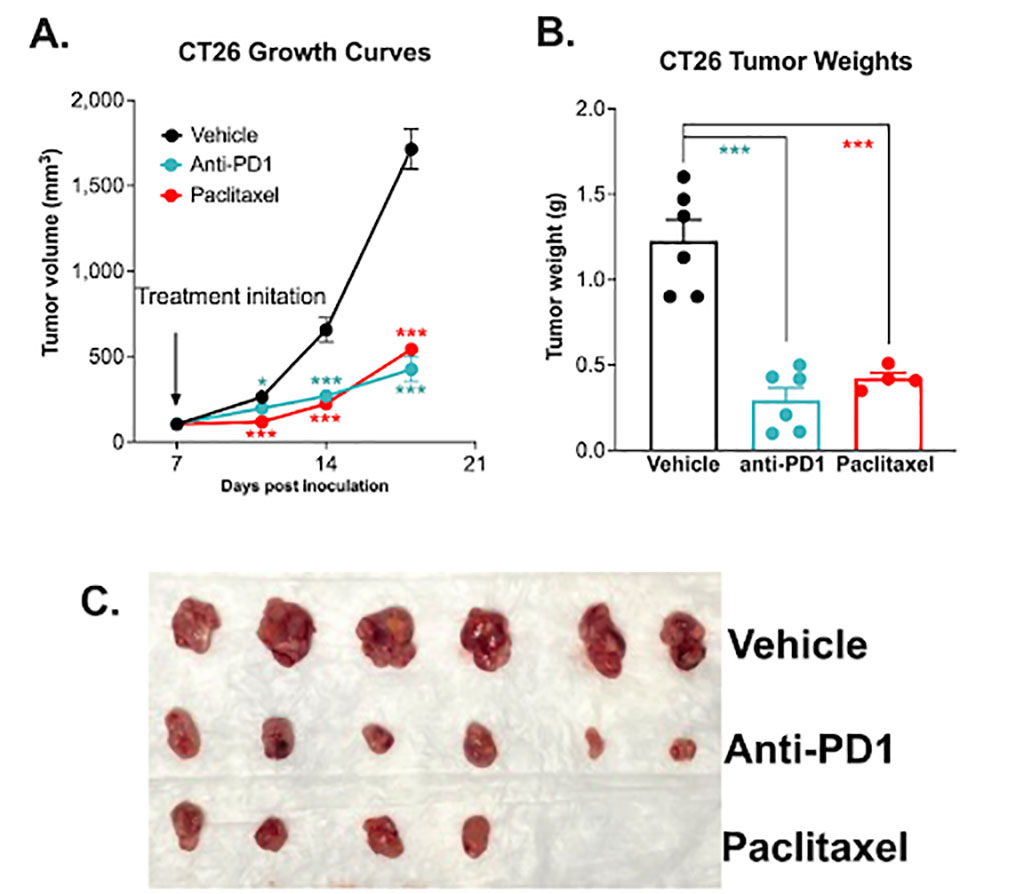The CT26 Tumor Model For Colorectal Cancer
Investigate novel cytotoxic and immune-modulating therapeutics for colorectal cancer with the syngeneic CT26 mouse model.
Colon cancer and rectal cancer (together colorectal cancer; CRC) are the third most common and lethal cancer types, responsible for killing almost 1 million people every year.
You can develop better treatment candidates fast with Melior’s CT26 syngeneic model —a fast-growing tool for the rapid, reliable investigation of novel therapeutics and effective checkpoint inhibitors.
The Current CRC Treatment Landscape
Surgical intervention is first-line therapy for nearly all CRC patients, but multidisciplinary treatment is vital for preserving longevity and quality of life. Advances in surgical, chemotherapy, and radiotherapy methods have significantly improved outcomes for patients with CRC, but the need for validated, targeted therapies remains urgent.
Drug discovery—developing new pharmacological interventions through invention and innovation – has produced leaps in the CRC therapy world. But clinical trials may also focus on repurposing known drugs for new targets, combining existing drugs to test if they work better in partnership, and designing multiplex strategies that exploit the diverse tools in the current CRC treatment toolbox—across chemotherapy, radiotherapy, immunotherapy, and targeted treatments.
Melior’s CT26 mouse model facilitates these goals and de novo development work to improve clinical and survival outcomes for CRC patients.
Rewrite Cancer Therapy with the CT26 Tumor Model
The CT26 tumor model uses a cell line established from BALB/c mice treated with N-nitroso-N-methylurethane (NNMU), a known carcinogenic, to induce colon carcinoma. Researchers can use the CT26 syngeneic model in isolation or to complement our other xenograft human colon cancer (HCT-15) and human PDX colon cancer models.
By implanting colon cancer cells into immunocompetent mice, researchers can study key interchanges between tumor cells and the immune system of the same genetic strain. As a result, the syngeneic CT26 tumor model is equally suitable for investigating immune-modulating and cytotoxic therapeutic avenues. This makes it a necessary addition to the preclinical CRC research armamentarium.
The CT26 syngeneic mouse model yields highly reproducible tumor growth curves capable of detecting minute changes in relatively small group sizes. Whether you are looking to gauge the effectiveness of small molecules, evaluate gene therapies, or test the safety and potency of immune-modulating agents, you can use the CT26 tumor model to complete your in vivo efficacy assessments with confidence.
The CT26 Tumor Model You Can Rely On
Our established CT26 syngeneic mouse model can help push your therapeutic cancer research forward. When you choose Melior, enjoy a preclinical CT26 syngeneic model that is:
- Fast growing ( only ~10 days to establish and ~10 days treatment)
- Highly reproducible
- Well-represented in the literature
- Capable of detecting small changes in growth rates
- Responsive to various immunotherapies, including immune checkpoint inhibitors
- Accurate in mimicking the human tumor microenvironment
- Cost-effective compared to other preclinical models
Tailor-made Services: Designed With You In Mind
Initiate your CT26 tumor model study quickly with a bespoke design to suit your needs. In as little as 3-4 weeks, we help you go from design to results with our flexible, custom services.
Our bespoke analyses include:
- Tissue collection for immune cell analysis and profiling
- Whole blood, spleen, and lymph node analysis
- General observations, including pain analysis
- Histology and IHC
- Luciferase assay
- IVIS imaging
- FACS analysis
- PK studies
Ready to get started or looking for a custom model?
We offer face-to-face Zoom calls, ad-hoc consultations, and customized study proposals. Take advantage of a direct line to experienced project managers and our hands-on approach to revision support.
For a comprehensive list of services.
Expand Your Applications with Immuno-theraTRACEⓇ
With our oncology platform, Immuno-theraTRACE®, you can test your immunotherapeutic across 8 syngeneic models. This helps you determine the best target cancer type to advance your immunotherapy.
In addition to testing your drug in our CT26 tumor model, Immuno-theraTRACE® screens immune-modulating agents, including immune checkpoint inhibitors, for their therapeutic potential across a range of tumor types ranging from cold tumors to hot tumors.
All this in a matter of weeks.
This model is included in our Immuno-theraTRACE® oncology platform
Did you know this CT26 tumor model has a complementary colorectal cancer xenograft?
We have established a human colorectal cancer (CRC) xenograft model using the HCT-15 cell line. The model is conducted in nude mice lacking T cells and is, therefore, suitable for investigating cytotoxic candidates and other non-immune modulating therapies.

Immune Checkpoint Inhibitor and Chemotherapy Validation of a CT26 Syngeneic Mouse Model. The CT26 tumor model is created by subcutaneously injecting 1 x106 CT26 cells into the rear flank of Balb/c mice. Once the tumor size reached ~120mm3 (Day 7), mice were randomized into the vehicle control group (treated with normal saline), anti-PD-1 antibody (12.5 mg/kg, IP once per week), or paclitaxel (20 mg/kg, IP once per week). Tumor volume was monitored twice per week using calipers (A). At the end of the study (Day 18), animals were sacrificed, and tumors were excised and weighed (B, C). N=6 for vehicle and anti-PD-1, N=4 for paclitaxel. Data area mean ± SEM. * P<0.05, ** P<0.01 *** P<0.001 by Student’s t-test.
Publications
Frequently Asked Questions
CT26 is a murine colon carcinoma cell line derived from a BALB/c mouse. It is commonly used in cancer research to study colon cancer and tumor immunology. The CT26 tumor model is particularly valuable because it can be used in syngeneic BALB/c mice, allowing researchers to investigate tumor-immune system interactions in an immunocompetent environment. This model helps to provide insights into the mechanisms of tumor growth and metastasis and the potential for developing new cancer treatments.
MC38 and CT26 are both murine colon carcinoma cell lines used in cancer research, but they have distinct origins and applications. Whereas MC38 is derived from a colon adenocarcinoma induced by a carcinogen (dimethylhydrazine) in C57BL/6 mice, CT26 is derived from a chemically-induced colon carcinoma in BALB/c mice. Both can be used in syngeneic models to study tumor-immune interactions and immunotherapies. Both are complementary tools in cancer research, enabling researchers to choose the mouse strain with the immune profile that aligns best with their study objectives or using both models to gain comprehensive insights across different genetic and immunological contexts, enhancing the robustness of the cancer R&D findings.
Yes, the HCT-15 xenograft model for human colorectal cancer (CRC) can be used to investigate possible therapeutic candidates, such as those that work by inducing cytotoxicity. However, unlike the CT26 syngeneic model, xenografts operate in immunocompromised mice and are not ideal for evaluating immune-modulating therapies. For this, researchers can use the CT26 syngeneic model in combination with the xenograft human colon cancer (HCT-15) and other human PDX colon cancer models to complement their studies and advance their CRC R&D.
Citations
- World Health Organization (2022) Cancer. Available at: https://www.who.int/news-room/fact-sheets/detail/cancer (Published 03 February 2022, Accessed: 06 June 2023).
- The American Cancer Society (2023) Colorectal cancer research: New colorectal cancer treatments, Colorectal Cancer Research | New Colorectal Cancer Treatments. Available at: https://www.cancer.org/cancer/types/colon-rectal-cancer/about/new-research (Published 30 March 2023, Accessed: 06 June 2023).





